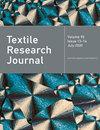连续聚酯长丝芯吸效应的三维螺旋模型
IF 1.9
4区 工程技术
Q2 MATERIALS SCIENCE, TEXTILES
引用次数: 0
摘要
吸水效应是促进纱线和织物中液态水的进入和转移的关键因素。在后续产品加工过程中,特别是在纺织基复合材料的浸入和界面粘合方面,吸湿效应的重要性尤为突出。捻度对纱线内的纤维排列和密度,以及纱线和液态水的吸湿途径都有深远的影响。我们使用的数学模型以三维螺旋毛细管渗透机制为基础,与捻度因素有着内在联系。该模型假设纱线纤维的直径和排列均匀一致。利用宏观力平衡法,推导出液体毛细管上升与吸水时间的函数,并使用 COMSOL 平台模拟了纱线内液态水上升的动态过程。随后,在不同捻度的涤纶长丝上进行了一系列吸水实验。结果表明,实验数据与理论预测完全吻合,从而肯定了模型的准确性。本文章由计算机程序翻译,如有差异,请以英文原文为准。
Three-dimensional spiral model of the wicking effect for continuous polyester filaments
The wicking effect constitutes a pivotal determinant in facilitating the ingress and transference of liquid water within yarns and fabrics. Its significance looms prominently in the context of subsequent product processing, particularly concerning the immersion and interface bonding of textile matrix composites. The twist exerts profound influence over the fiber disposition and density within yarns, as well as the yarn and the wicking pathways for liquid water. We use a mathematical model grounded in the three-dimensional helical capillary permeation mechanism, inherently linked to the twist factor. This model operates under the assumption that the yarn's fibers exhibit uniform diameters and arrangements. Leveraging the macroscopic force equilibrium method, a function of liquid capillary rise with wicking time was deduced. and the dynamic progression of liquid water ascent within the yarn was simulated using the COMSOL platform. Subsequently, a series of wicking experiments were executed on polyester filament yarns, each characterized by varying twist levels. The results revealed that the experimental data coincided well with the theoretical prediction, thus affirming the model's accuracy.
求助全文
通过发布文献求助,成功后即可免费获取论文全文。
去求助
来源期刊

Textile Research Journal
工程技术-材料科学:纺织
CiteScore
4.00
自引率
21.70%
发文量
309
审稿时长
1.5 months
期刊介绍:
The Textile Research Journal is the leading peer reviewed Journal for textile research. It is devoted to the dissemination of fundamental, theoretical and applied scientific knowledge in materials, chemistry, manufacture and system sciences related to fibers, fibrous assemblies and textiles. The Journal serves authors and subscribers worldwide, and it is selective in accepting contributions on the basis of merit, novelty and originality.
 求助内容:
求助内容: 应助结果提醒方式:
应助结果提醒方式:


